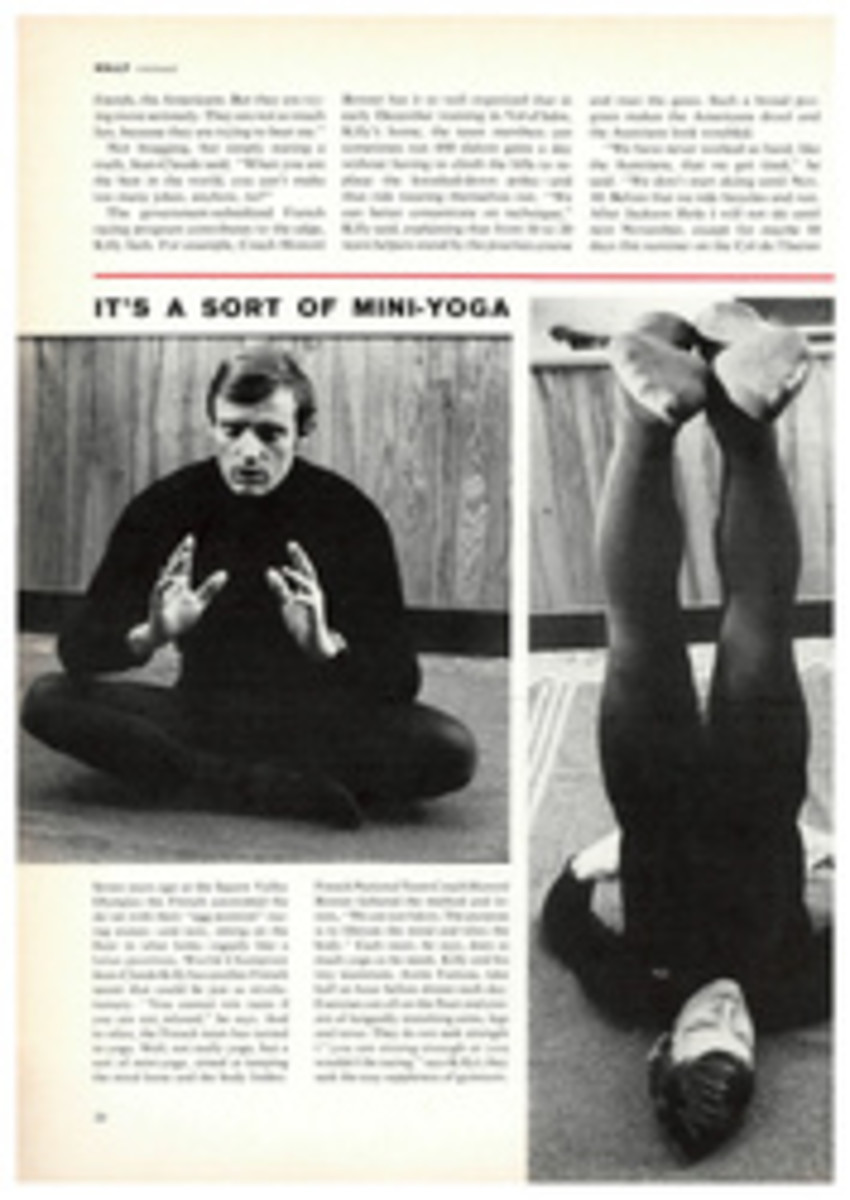
'Garrick!' says the crow, and also 'Bah! Humbug!'
Crows hate to get up in the morning. They like to perch near the top of a small tree with lots of other crows around, and stay there. There are 10 million crows now spending the nights at a roost near Fort Cobb Lake in the Oklahoma peanut country—more crows than have ever been sighted in one place before—and when the sky begins to grow light you can see the ones in the nearest trees stirring grumpily. They shift their weight from side to side like parrots in a cage, and scrouge down like a man pulling the blankets over his head.
At the same time they make a peculiar early-morning crow sound indicating utter disgust with the world. Louis-Ferdinand Céline never expressed such dislike for the human lot as these half-awakened crows express for the destiny of Corvidae corvus. Samuel Rhoads, the first American ornithologist to make a study of crow roosts, wrote in The American Naturalist 80 years ago that a crow waking up makes a squawk "which sounds something like 'garrick.' " So it does, but it also sounds like bah! humbug! yeah! yeah! yeah! caw! caw! caw! and other morose sentiments.
At Fort Cobb Lake, when the first crows come out of the densely packed trees they fly sleepily a few feet and then perch on a fence, or even land on the ground, yawning and yakking and garricking and cawing and evidently cursing the loudmouthed warblers that are happily greeting the new day in the brush around them.
And anyway, what incentive does a crow have to get up early? The U.S. Government protects the white-capped noddy, the boat-tailed grackle and more than 600 other birds, but you can shoot a crow in Oklahoma or anyplace else any time you want to. Last year in that state 16,524 hunters killed 446,148 crows. Sometimes around Fort Cobb Lake the sound of gunfire is constant. True, the crow shooters miss many more crows than they hit. But crows are so nervously constituted that the sound puts them under a constant strain; even a loud noise that resembles a shotgun will send an entire flock flying to another peanut field. Then there are carbide guns, which are used to keep crows away while the peanuts are harvested. These are contraptions in which drops of water fall on carbide and, at 40-second intervals, create terrific explosions. And now propane-and butane-gas guns have been developed, creating the same sound and unnerving the crows even more.
Even less to the crows' liking is the three-year research project into their behavior that is now under way at Fort Cobb Lake, the first of its kind anywhere. If there is one thing a crow hates more than being shot at it is being caught by the legs while sleeping on its roost. A hawk being banded looks like it wants to kill the man banding it. A small bird looks surprised that it hasn't been killed, but a crow demands to see his lawyer.
"Last year I banded 117," said Gerald Iams, the conservation department biologist at Fort Cobb Lake." There were a lot of damp, foggy nights, and you could sneak in and grab them off the low branches. This year it's been so dry, every step makes so much noise they can hear you coming. By the time you get to a tree, they're gone."
For a time Iams used a dip net, with a long pole affixed to it. He would crouch in the thickets and swing the net when he saw a likely-looking bird. This year there were so many more crows than usual that all the trees in the roost were filled every night and the overflow rested on the ground. Iams switched to a cannon net, which catapults and covers an area 40 by 60 feet. The cannon was a banging success. In just one shot he captured and banded 387 birds.
One cold morning I went out with Iams to watch the crows wake up. The sky was cloudless to the horizon, and the fresh air was motionless. Fort Cobb Lake is a beautiful, secluded body of light-blue water, brimming up between low hills. The lake provided a shining patch of light in the semidarkness, against which the crows on the trees were plainly seen; otherwise they could hardly have been distinguished. A skunk came out of the brush and crossed a cleared space in front of the blind. Half a dozen early-rising crows made perfunctory passes at the skunk. They dropped down from one side or the other alternately, swooping just over the skunk's back, but it did not seem to be alarmed, and they appeared to be merely going through the motions.
Individually the crows muttering before daylight would not make much noise. But when you get 10 million birds all making a low-voiced complaint you can hear them two miles away. When the sky in the east was the color of old ivory the crows came boiling above the tree tops in gigantic waves. The sky became dark, with patches of light shuttering as the birds wheeled and gyrated and climbed higher and new flights rose after them. The sounds began mounting to a roar, a mixture of exultant cawings and yellings, like 10 million spectators cheering continuous touchdowns. The crows twisted and turned and crisscrossed each other's path, so closely it seemed they touched. The sound died away and then rose in another wave, louder than the last, every bird in the roost climbing into the air and singing some crow version of Oh, What a Beautiful Mornin' before they set out to steal some farmer's peanuts. They were wide awake at last.
Crows have been coming into central Oklahoma since the land was cleared, but there has never been anything like the Fort Cobb Lake roost before. The increasing crow population of Oklahoma first appeared in ornithological reference works in 1926, when the pecan growers of Verden, a few miles southeast of Cobb Creek, dynamited a roost and killed 11,000 crows. That was considered a lot at the time, and it was reported that one roost was believed to hold as many as 100,000 birds. Cobb Creek is right on the edge of the Dust Bowl that Steinbeck pictured in Grapes of Wrath, and during the Depression the crow population, undiscouraged by dynamite, became the final hardship for a lot of farmers. They watched their crops being eaten up, and they cleared out. The great boost to the farmers—and to the crows—came when peanuts were planted as an experiment around 1938. Crows think peanuts are the greatest improvement since the discovery of wings. They get to Cobb Creek from the north in time for the peanut harvest and leave in the spring just before the farmers prepare the ground for planting. During their sojourn they go over the fields, picking up the peanuts that have been left behind. However, they can expect to be shot at on the way to and from their feasting. The Department of Wildlife Conservation calculates that during the six months the crows last wintered in this area hunters shot 723,000 shotgun shells around there, without materially affecting the crow population.
You can get a sharp sign of the mass intelligence of Fort Cobb Lake crows by watching them come into the roost at night. The lake was formed six years ago by an earth dam that backed up the water seven miles. Inlets and crevices give the mile-wide lake a saw-tooth shoreline. Near the north end of the lake, where one of these inlets reaches back two miles, the crows make their roost on a jagged point of land. The lake gives them protection on two sides, the inlet gives them protection on another. On the remaining side the only approach is through an almost impenetrable growth of blackjack. Napoleon could not have picked cut a better defensive location.
Coming in to roost, the crows make no such display as they make in leaving. Half an hour before sunset there is not a crow in sight. Then a few scouts fly over the roost. About two miles from the roost, radiating out like the spokes of a wheel, the crows assemble at staging points in the fields. Just at sunset they stream in over the trees in long wavering lines, very fast and nearly silent. If a hard wind is at their backs they swoop along with it in swaying motions that suggest ice skating. As they drop out of the sky you cannot see them landing on the trees, but you can see the top branches getting bigger, until they look like girders for a building.
Nor can you see the ones that arrive late, find the no-vacancy sign up and sleep on the ground. But they are there. The night after Gerald Iams shot his cannon net and got his big haul, he went back and found that there was a vacant space all around his blind deep in the roost. You could crouch down in the sand there, look up and see crows everywhere except overhead. Regardless of what the behavior tests indicate on crow intelligence, the crows in the Fort Cobb Lake roost look like the world's least threatened species.
PHOTO

